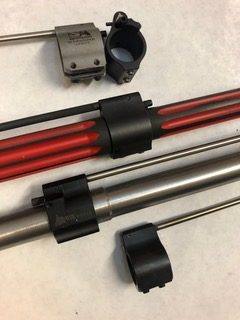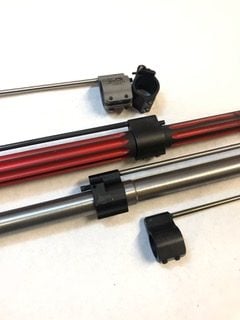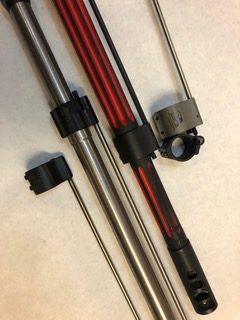Gas Blocks/Keys, and Gas Length All Play a Role
In a previous post ( https://www.rainierarms.com/blog/whats-the-best-muzzle-device )
I went over the first step in achieving a flat-shooting rifle: The muzzle device. I mentioned that was one piece of the puzzle, now I’d like to take a look at the next step a shooter can take to try to tame their recoil and exaggerate to their friends about how it shoots “softer than a .22lr!”
Adjustable Gas
For taming an AR-pattern rifle’s recoil, the second item I would look at (after the muzzle device) would definitely be an adjustable gas system. As a general rule, rifles are over-gassed. Over the years it has become common practice to use M16 bolt carriers, H/H2/H3 buffers, extra bower buffer springs, pigtail gas tubes, etc. to help tame the beast. Most of it, though, simply comes down to an excess of gas pressure. All the aforementioned methods of adding weight make sense if the shooter is stuck with a fixed amount of pressure acting on their BCG, but thankfully that is a problem of the past.

The most common method of reducing gas pressure is an adjustable gas block. These are available from a wide variety of manufacturers, for any common diameter barrel you could own. The durability and reliability of them to be adjusted down the road may vary, but the current generations of gas blocks have come a long way. Personally, I do recommend opening and closing the gas adjustments a little bit from time to time if you wish to retain adjustability. The carbon build-up will lock-up most blocks over time, but if it tuned to your system that may not be a problem. Some are actually built to be adjusted initially, and then left with no intention of moving again. I believe the thought behind this is that they have less moving parts to fail, but allow you to tailor it to your setup.
Another method, which I admittedly have never personally run, is an adjustable gas key. This is a different way of tackling the same issue – i.e. High gas pressure cycling the bolt. These keys will change the amount of gas that is actually utilized by the bolt carrier to create motion, much like the adjustable gas blocks. Conceptually, I prefer the idea of limiting the amount of gas sent into the receiver, but adding a carrier with an adjustment may be a simpler retrofit for some shooters.
Setting it Just Right
An analogy I see regularly for your rifle’s reciprocating system goes something like this:
Imagine you are tasked with jumping onto a box in a room with a low ceiling. You want to jump high enough to land on the box, yet not slam your head into the ceiling. In our analogy the box would be the bolt catch, and the ceiling would be the rear of the buffer tube/receiver extension. We want that bolt carrier group travel rearward far enough to land on the bolt catch if the magazine is empty, but not slam rearward with excessive force.

The generally accepted method is to close the gas system so little to no gas is flowing. Using your ammunition of choice, load one round in the magazine and fire. Most likely you will get a failure to extract, which means there was not enough pressure to cycle the bolt. Open the gas a couple clicks at a time until you find that point where the bolt just barely catches on the bolt catch when that round is fired, then open it a little bit more. One “click” may work, but most people will set the adjustment somewhere from 2 clicks to one full rotation more open than “barely functioning,” so their rifle still functions if cold weather reduces the “hotness” of the ammo, or their gun gets dry/dirty. At this point, lock it down if that is an option and test a few different magazines (and if possible, different temperature ranges and levels of cleanliness).
If, like the Superlative Arms gas blocks, you have the option of “bleeding off” the excessive gas, I would recommend not using that setting for typical use. For suppressed use, though, this can be a nice feature. Unsuppressed I have seen reports it reduces bullet velocity, and have heard of some reliability issues that were solved by simply going to the non-bleed-off settings.
Extend That Gas Tube

Finally (for gas, anyway), one should be paying attention to the length of the gas system. The gas that cycles our rifles comes from the expanding gas still propelling the projectile once the bullet passes the gas port. So when we add barrel length without moving the gas port forward (like changing the 14.5” barrels the carbine-length system was designed for into a 16” barrel for legality reasons), we have added to the amount of gas working the system. Many barrel manufacturers offer mid-length, intermediate length, and rifle-length gas systems in their 16” and 18” barrel offerings. These options should make it easier to tune the rifle to be soft-shooting versus carbine-length, as there is less “dwell time” (the duration the bullet is in the barrel after passing the gas port). I have heard of people having issues with the rifle-length gas in a 16” barrel, but many others seem to make this combination work flawlessly. It may be an issue of carrier weight, or something in the rear of the rifle needing more gas than this system offers, it is hard to know without testing. I, personally, run a rifle-length gas system in an 18” barrel, or an intermediate for a 16” barrel. Generally speaking, the longer the gas system (within reason) for the length of barrel the shooter is looking for, the easier it will be to get the rifle tuned to shoot soft and “flat.”
Covering My Rear-End
While I have seen many rifles set-up with all the go-fast goodies function flawlessly for thousands upon thousands of rounds, I would be remiss to not mention this: The primary purpose for chasing a rifle that shoots extremely soft and flat is competition and target shooting. I, personally, have no problem with the idea of adjustable gas and a reduced-mass carrier in my “defensive” or “SHTF” rifle, but that goes against the grain, and I would do extensive testing on that particular firearm to ensure reliability. For better or worse, the accepted convention for a rifle that may get abused, extremely dirty, etc. and still need to function is to leave it over-gassed with a standard gas block and add some weight to the reciprocating system.








